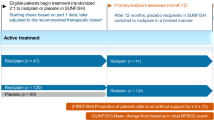Abstract
Spasticity can be a very disabling problem in some amyotrophic lateral sclerosis (ALS) phenotypes, such as upper motor neuron-dominant ALS (UMN-D ALS) and primary lateral sclerosis (PLS). Our aim is to describe the safety and efficacy of botulinum toxin A (BoTox-A) for improving gait in those ALS phenotypes. UMN-D ALS and PLS outpatients experiencing gait disturbances, secondary to moderate-to-severe spasticity despite optimized oral medication, were offered BoTox-A treatment. Stretching exercises were indicated to complement BoTox-A effect, and ankle–foot orthotics were prescribed when appropriate. Tolerance (muscle strength, disease progression rate) and efficacy (10-m walk test) were measured at baseline and after treatment. Eight out of 122 ALS outpatients were offered BoTox-A treatment. One declined and the other seven were administered BoTox-A in the lower limbs, every 5–8 months. All of them experienced improvement in the clinical outcome and all but one referred subjective improvement. Moreover, after a median follow-up of 16 months and three injections, BoTox-A effect was maintained with no adverse events. This study provides class IV evidence that BoTox-A is safe , and could be beneficial in the short term and long term in a subset of ALS patients with moderate-to-severe spasticity.


Similar content being viewed by others
References
Kheder A, Nair KPS (2012) Spasticity: pathophysiology, evaluation and management. Pract Neurol 12:289–298. doi:10.1136/practneurol-2011-000155
Swash M (2012) Why are upper motor neuron signs difficult to elicit in amyotrophic lateral sclerosis? J Neurol Neurosurg Psychiatry 83:659–662. doi:10.1136/jnnp-2012-302315
Gordon PH, Cheng B, Katz IB et al (2006) The natural history of primary lateral sclerosis. Neurology 66:647–653. doi:10.1212/01.wnl.0000200962.94777.71
Chiò A, Calvo A, Moglia C et al (2011) Phenotypic heterogeneity of amyotrophic lateral sclerosis: a population based study. J Neurol Neurosurg Psychiatry 82:740–746. doi:10.1136/jnnp.2010.235952
Baker JA, Pereira G (2013) The efficacy of botulinum toxin A for spasticity and pain in adults: a systematic review and meta-analysis using the grades of recommendation, assessment, development and evaluation approach. Clin Rehabil 27:1084–1096. doi:10.1177/0269215513491274
Nair KPS, Marsden J (2014) The management of spasticity in adults. BMJ 349:g4737. doi:10.1136/bmj.g4737
Cioncoloni D, Taddei S, Bielli S et al (2014) Meaningful improvement in walking performance after botulinum neurotoxin A (BoNT-A) in chronic spastic patients. NeuroRehabilitation 34:185–192. doi:10.3233/NRE-131021
Alabajos Cea A, Máñez Añón I, Roda Alcayde C et al (2016) Decreased spasticity in primary lateral sclerosis after botulinum toxin injection: a case report. Neurologia. doi:10.1016/j.nrl.2016.01.005
Kimura F, Fujimura C, Ishida S et al (2006) Progression rate of ALSFRS-R at time of diagnosis predicts survival time in ALS. Neurology 67:1314–1315. doi:10.1212/01.wnl.0000243812.25517.87 (author reply 1314–5)
Cedarbaum JM, Stambler N, Malta E et al (1999) The ALSFRS-R: a revised ALS functional rating scale that incorporates assessments of respiratory function. BDNF ALS Study Group (Phase III). J Neurol Sci 169:13–21
Florence JM, Pandya S, King WM et al (1992) Intrarater reliability of manual muscle test (Medical Research Council scale) grades in Duchenne’s muscular dystrophy. Phys Ther 72:115–122 (discussion 122–6)
Perry J, Garrett M, Gronley JK, Mulroy SJ (1995) Classification of walking handicap in the stroke population. Stroke 26:982–989
Ashworth NL, Satkunam LE, Deforge D (2006) Treatment for spasticity in amyotrophic lateral sclerosis/motor neuron disease. Cochrane Database Syst Rev CD004156. doi: 10.1002/14651858.CD004156.pub4
Andersen PM, Abrahams S, Borasio GD et al (2012) EFNS guidelines on the clinical management of amyotrophic lateral sclerosis (MALS)–revised report of an EFNS task force. Eur J Neurol 19:360–375. doi:10.1111/j.1468-1331.2011.03501.x
Kent L, Davies P, Kennett R et al (2013) Unmasking of incipient amyotrophic lateral sclerosis by botulinum toxin therapy. J Neurol 260:1166–1167. doi:10.1007/s00415-013-6854-x
Restivo DA, Zappia M, Elia M, Romano MC (2013) ALS dysphagia pathophysiology. Differential botulinum toxin response. Neurology 80:616–620. doi:10.1212/WNL.0b013e318281cc1b
Acknowledgments
The authors thank Ignacio Dobón and Rosa Mª Vilar for their collaboration in patient recruitment. We also thank Victoria Fornés Ferrer for her help in graphics design.
Funding
The research leading to these results has received funding from Instituto de Investigación Sanitaria La Fe (2013/0332, PI Vázquez/Sevilla) and from Instituto de Salud Carlos III (ISCIII, PI12/0946, PI Sevilla). The Centro de Investigación Biomédica en Red de Enfermedades Raras (CIBERER) is an initiative from the ISCIII.
Author information
Authors and Affiliations
Corresponding author
Ethics declarations
Conflicts of interest
The authors declare that they have no conflict of interest.
Ethics approval
The ethical committee for biomedical research of Hospital La Fe has approved this study. All participants gave their informed consent prior to their inclusion in the study.
Rights and permissions
About this article
Cite this article
Vázquez-Costa, J.F., Máñez, I., Alabajos, A. et al. Safety and efficacy of botulinum toxin A for the treatment of spasticity in amyotrophic lateral sclerosis: results of a pilot study. J Neurol 263, 1954–1960 (2016). https://doi.org/10.1007/s00415-016-8223-z
Received:
Revised:
Accepted:
Published:
Issue Date:
DOI: https://doi.org/10.1007/s00415-016-8223-z




